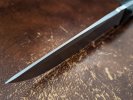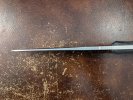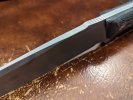Nathan the Machinist
KnifeMaker / Machinist / Evil Genius
Moderator
Knifemaker / Craftsman / Service Provider
- Joined
- Feb 13, 2007
- Messages
- 18,283
Which one do you prefer?
The HDFK is somewhat thinner stock which creates a larger flat above the primary which lends itself to a fuller which allows more aggressive weight removal in the tang which makes for a nice light well balanced tool. It also has a well thought out finger choil. It's finely tuned and refined, which I like. Refined is a good word for it. An excellent example of synergy in the collaboration between Lorien and myself, it's a fantastic piece. That said, I really like the SDFK because it begs me to smash shit with it which is fun. Obviously the HDFK is the better choice for a camping trip but I'm not on a camping trip and if I were I'd take an FK2 and my Behemoth because I don't need a one-knife-solution. But that's just me.
The HDFK is possibly the best one-size-fits-all knife solution that we have ever produced. It's truly fantastic. The SDFK is merely cool.
20 ga bird gun vs 12 ga. They blow the shit out of stuff but the 20 is more gentlemanly?
IDK. I'm enjoying the SDFK quite a lot honestly.



